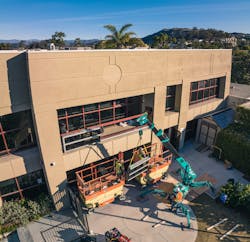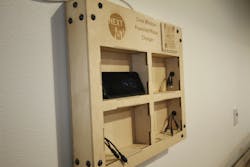Normally thought of as an energy drain, windows notoriously make it harder to save energy. Even the most well-sealed windows still allow heat transfer more easily than walls.
But that may be about to change. A newly developed window actually generates energy to make up for some of what’s lost.
Developed by NEXT Energy Technologies, transparent energy-generating windows recently made their debut on a building following three demonstrations of freestanding facade units containing the technology. The windows—22 in total—were recently installed on the south facade of the Olive Building at the corporate headquarters of Patagonia, the outdoor apparel company based in Ventura, California. The Olive Building houses offices, an employee gym and a climbing wall.
The windows are a marked departure from other building-integrated photovoltaics (BIPV), which are usually black and opaque, said Jeff Horowitz, director of business development and partnerships for NEXT.
“This approach uniquely allows our BIPV windows to look like conventional windows,” Horowitz explained.
How Solar Windows Are Made
- Solution-processed: The materials are coated on the windows as an ink in a high-speed, low-cost, low-energy process, so they don’t need the expensive equipment required for the coating process used for traditional black PV.
- Small molecules: “Other organic photovoltaic technologies have been plagued by low lifetimes, but being in a window, we have to last 20 to 30 years,” Horowitz said. “The small molecule piece of our technology allows us to have intrinsic stability in our material.”
- Organic semiconductors: NEXT uses carbon-based materials that allow the visible spectrum through, something inorganic semiconductors can’t achieve, Horowitz said.
The transparent PV coating is printed directly onto architectural glass, then sealed behind another sheet of glass and integrated into a traditional glazing system. The windows carry cables that deliver renewable energy to be used within the building. In Patagonia’s case, the cables deliver power to a battery bank in a community space for employees, giving them a renewable way to charge devices. People using the space can also explore a custom landing page that tracks real-time peak production capacity, the number of phones charged and other metrics.
Walters & Wolf designed, fabricated and installed the glazing system integrating NEXT’s technology. The glass fabricator of the module units was performed by SolarFab, a division of GlassFab Tempering Services.
Why Solar Windows?
“We’ve been using solar power at our headquarters in Ventura since 2005 and at our Reno Distribution Center since 1996,” said Corley Kenna, head of communications and public policy at Patagonia. “We have funded more than 1,000 solar arrays on homes across the U.S. and have helped install more than 600 kilowatts of solar power globally to support agriculture. Finding better ways of doing business is something we always strive to do, and we’re pleased to partner with NEXT Energy to help us be a more responsible company.”
Windows are an underutilized asset when it comes to energy generation, Horowitz said. NEXT’s windows have lower power generation per panel than the typical non-transparent PV because the visible light spectrum is allowed to pass through the window instead of being absorbed and turned into power, Horowitz explained. However, because the facade area is larger than what’s available on the roof, the overall amount of power generated should be significant.
NEXT estimates that its windows could produce 20-30% of the power produced by conventional solar panels alone; however, by leveraging the surface area of the building’s facade rather than relying solely on the rooftop, solar windows could offset anywhere from 10-40% of a typical commercial building’s energy load, according to the company. Maintenance is similar to what a typical rooftop installation would need; the inverter used typically has a lifetime of 15-20 years and may need to be replaced later, but otherwise the windows are built to last.
“Hopefully, the installation serves as a window into the future, in a sense,” Horowitz said. “It’s a valuable use case for the building and construction industry to illustrate climate-positive outcomes that customers have now come to want and expect in their buildings—those being ongoing lifecycle value, passive optimization, operational efficiency and energy self-sufficiency by producing your own energy.”
About the Author
Janelle Penny
Editor-in-Chief at BUILDINGS
Janelle Penny has been with BUILDINGS since 2010. She is a two-time FOLIO: Eddie award winner who aims to deliver practical, actionable content for building owners and facilities professionals.



